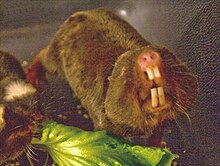
In biology, a colony is composed of two or more conspecific individuals living in close association with, or connected to, one another. This association is usually for mutual benefit such as stronger defense or the ability to attack bigger prey.
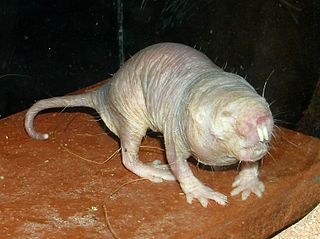
The naked mole-rat, also known as the sand puppy, is a burrowing rodent native to the Horn of Africa and parts of Kenya, notably in Somali regions. It is closely related to the blesmols and is the only species in the genus Heterocephalus.

The blesmols, also known as mole-rats, or African mole-rats, are burrowing rodents of the family Bathyergidae. They represent a distinct evolution of a subterranean life among rodents much like the pocket gophers of North America, the tuco-tucos in South America, or the Spalacidae from Eurasia.

Sociality is the degree to which individuals in an animal population tend to associate in social groups (gregariousness) and form cooperative societies.
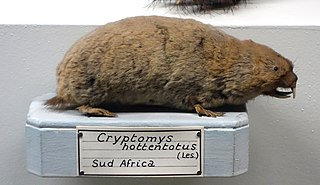
Cryptomys is the genus of mole-rats, endemic to Africa. Most of the species formerly placed in this genus were moved to the genus Fukomys in 2006.

The Cape mole-rat is a species of mole-rat endemic to South Africa. It is the only extant species currently described as belonging to the genus Georychus.
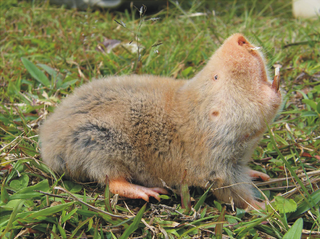
The silvery mole-rat, silvery blesmol, or silky mole-rat is a species of mole-rat of East Africa which occurs in southern Kenya, Tanzania, southeastern Democratic Republic of Congo, Mozambique and Malawi. Solitary and aggressive, little is known about its ecology or behavior. It is monotypic in the genus Heliophobius. A common species, the International Union for Conservation of Nature has rated it as being of "least concern".
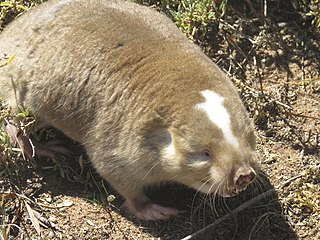
The Cape dune mole-rat is a species of solitary burrowing rodent in the family Bathyergidae. It is endemic to South Africa and named for the Cape of Good Hope.

Ansell's mole-rat is a species of rodent in the family Bathyergidae. It is endemic to Zambia. Its natural habitats are moist savanna and miombo forests. It is noted for its very long tunnels, up to 2.8 km (1.7 mi) for a single colony of only ten individuals. The colonies are made of an eusocial system. They include a main reproductive king and queen that are thought to be faithful to one another.
The Nigerian mole-rat is a species of rodent in the family Bathyergidae. It is found in northern Nigeria and Cameroon. A colonial, subterranean species, its natural habitats are tropical dry lowland grassland, riverside woodland and rocky places.

Mechow's mole-rat is a species of rodent in the family Bathyergidae. It is found in Angola, Democratic Republic of the Congo, Zambia, and possibly Malawi. Its natural habitats are moist savanna, subtropical or tropical dry shrubland, and subtropical or tropical dry lowland grassland. This mole-rat was first described by the German naturalist Wilhelm Peters in 1881. The specific epithet honours the Prussian explorer and naturalist Friedrich Wilhelm Alexander von Mechow.
The Ghana mole-rat or Togo mole-rat is a species of rodent in the family Bathyergidae. It is endemic to Ghana.

The northeast African mole-rat is a species of rodent in the family Spalacidae and is found in Ethiopia, Somalia, and northwest Kenya. Its natural habitats are subtropical or tropical moist montane forests, dry savanna, high-altitude shrubland and grassland. It lives a solitary existence underground and produces a small litter of pups twice a year, in the two rainy seasons. Some taxonomic authorities lump this species, along with a number of others in the genus, in which case the English name East African mole-rat is used.

Rodents are mammals of the order Rodentia, which are characterized by a single pair of continuously growing incisors in each of the upper and lower jaws. About 40% of all mammal species are rodents. They are native to all major land masses except for New Zealand, Antarctica, and several oceanic islands, though they have subsequently been introduced to most of these land masses by human activity.
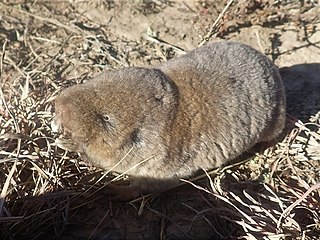
The common mole-rat, African mole-rat, or Hottentot mole-rat, is a burrowing rodent found in Southern Africa, in particular in the Western Cape province of South Africa. It also occurs in Eswatini, Lesotho, Malawi, Mozambique, Tanzania, Zambia, and Zimbabwe. It is a species in the subfamily Bathyerginae.

Eusociality, the highest level of organization of sociality, is defined by the following characteristics: cooperative brood care, overlapping generations within a colony of adults, and a division of labor into reproductive and non-reproductive groups. The division of labor creates specialized behavioral groups within an animal society which are sometimes referred to as 'castes'. Eusociality is distinguished from all other social systems because individuals of at least one caste usually lose the ability to perform at least one behavior characteristic of individuals in another caste. Eusocial colonies can be viewed as superorganisms.

Fukomys is a genus described in 2006 of common mole-rats, containing several species that were formerly placed in the genus Cryptomys; its species are endemic to Africa. The species contained in the genus includes :
The Matabeleland mole-rat is a species of mole-rat found in Zimbabwe.

Eusociality evolved repeatedly in different orders of animals, particularly the Hymenoptera. This 'true sociality' in animals, in which sterile individuals work to further the reproductive success of others, is found in termites, ambrosia beetles, gall-dwelling aphids, thrips, marine sponge-dwelling shrimp, naked mole-rats, and the insect order Hymenoptera. The fact that eusociality has evolved so often in the Hymenoptera, but remains rare throughout the rest of the animal kingdom, has made its evolution a topic of debate among evolutionary biologists. Eusocial organisms at first appear to behave in stark contrast with simple interpretations of Darwinian evolution: passing on one's genes to the next generation, or fitness, is a central idea in evolutionary biology.

Within the insect order Hymenoptera, the Halictinae are the largest, most diverse, and most recently diverged of the four halictid subfamilies. They comprise over 2400 bee species belonging to the five taxonomic tribes Augochlorini, Thrinchostomini, Caenohalictini, Sphecodini, and Halictini, which some entomologists alternatively organize into the two tribes Augochlorini and Halictini.
